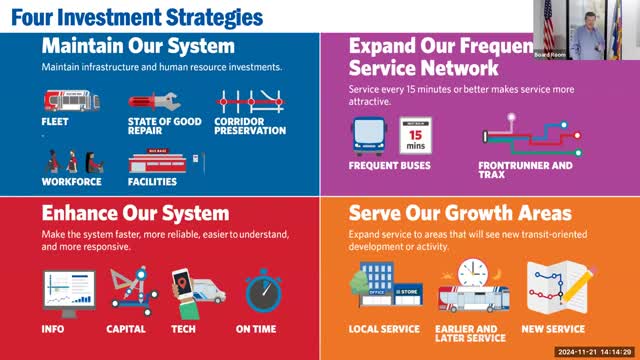Public transit updates Fleet Strategy with 40 electric buses and 20 natural gas buses
April 27, 2025 | Transportation Coordinating Committee, Wasatch Front Regional Council, Wasatch County Commission and Boards, Wasatch County, Utah
This article was created by AI summarizing key points discussed. AI makes mistakes, so for full details and context, please refer to the video of the full meeting. Please report any errors so we can fix them. Report an error »

In the heart of Wasatch County, a recent meeting of the Transportation Coordinating Committee illuminated the evolving landscape of public transit and infrastructure development. As discussions unfolded, the focus shifted to the integration of new technologies and the challenges that accompany them, particularly in the realm of electric and natural gas buses.
Carlton, a key presenter, shared insights into the current state of the bus fleet, highlighting a cautious yet optimistic approach to adopting electric vehicles. "We’re now approaching 40 electric buses and getting another 20 natural gas buses," he noted, emphasizing the importance of a balanced fleet. Historically, the clean-burning diesel buses have boasted a 95% operational rate, while the newer electric models faced a rocky start, with only 75% run time due to maintenance issues and technical glitches. This disparity underscores the complexities of transitioning to greener technologies.
The committee's discussions also touched on the operational capabilities of electric buses, which, despite their heavier weight and wider base, offer impressive power and quiet operation. However, the current infrastructure limits their use in certain areas, such as ski services, prompting a careful evaluation of where these vehicles can be most effective.
As the meeting progressed, Kendall Drainie, the Region 2 Program Manager, introduced upcoming capacity projects aimed at enhancing state routes. With nine projects in various stages of development, the focus remains on increasing capacity to meet growing demands. This initiative reflects a broader commitment to improving transportation infrastructure while integrating innovative solutions.
The committee's deliberations highlighted the importance of public input and collaboration with local advisory councils, ensuring that community needs are at the forefront of transportation planning. As the budget adoption approaches, the excitement for expanded services and improved transit options is palpable among committee members.
In conclusion, the meeting served as a reminder of the delicate balance between innovation and reliability in public transportation. As Wasatch County navigates this transition, the commitment to a sustainable and efficient transit system remains a priority, promising a future where technology and community needs align harmoniously.
Carlton, a key presenter, shared insights into the current state of the bus fleet, highlighting a cautious yet optimistic approach to adopting electric vehicles. "We’re now approaching 40 electric buses and getting another 20 natural gas buses," he noted, emphasizing the importance of a balanced fleet. Historically, the clean-burning diesel buses have boasted a 95% operational rate, while the newer electric models faced a rocky start, with only 75% run time due to maintenance issues and technical glitches. This disparity underscores the complexities of transitioning to greener technologies.
The committee's discussions also touched on the operational capabilities of electric buses, which, despite their heavier weight and wider base, offer impressive power and quiet operation. However, the current infrastructure limits their use in certain areas, such as ski services, prompting a careful evaluation of where these vehicles can be most effective.
As the meeting progressed, Kendall Drainie, the Region 2 Program Manager, introduced upcoming capacity projects aimed at enhancing state routes. With nine projects in various stages of development, the focus remains on increasing capacity to meet growing demands. This initiative reflects a broader commitment to improving transportation infrastructure while integrating innovative solutions.
The committee's deliberations highlighted the importance of public input and collaboration with local advisory councils, ensuring that community needs are at the forefront of transportation planning. As the budget adoption approaches, the excitement for expanded services and improved transit options is palpable among committee members.
In conclusion, the meeting served as a reminder of the delicate balance between innovation and reliability in public transportation. As Wasatch County navigates this transition, the commitment to a sustainable and efficient transit system remains a priority, promising a future where technology and community needs align harmoniously.
View full meeting
This article is based on a recent meeting—watch the full video and explore the complete transcript for deeper insights into the discussion.
View full meeting

